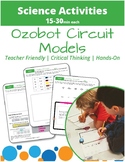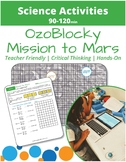Programming with the Ozobot: Mazes and Printable Sticker Codes
- Streaming Video(cannot be downloaded)
- Supporting Information
Also included in
- Learn circuits as you play with and program Ozobot robots!Each activity will lead the student through learning circuit vocabulary, matching mechanical drawings with our vocabulary, drawing circuits, modeling circuits, and even programming circuits!This bundle includes:Ozobot circuit matching activitPrice $5.00Original Price $7.00Save $2.00
- Get ALL of our Ozobot programming activities in one download. This bundle will grow with each new release, and I have a TON of fun Ozobot activities coming down the pipeline!Supplies NeededOzobot (Students can share)Maze printoutsOzobot markers, Ozobot stickers, or printable labels (the most cost efPrice $12.60Original Price $18.00Save $5.40
Description
Ozobots are a small line following robot that let kids learn the basics of programming in a variety of ways, including through color codes that can be laid down with markers or as stickers. This allows you to integrate hands-on programming into your classroom without the need for tablets, phones, or computers.
Ozobots can also be programmed using Blocky via tablets and (in the case of Evo) Bluetooth which allows you to scale the programming difficulty to individual students, or to multiple grade levels.
The downloads to this video include our growing Ozobot maze bundle and Ozobot color code sticker printables. The Ozobot mazes have empty boxes that can be colored in with markers or can have stickers overlaid to tell the Ozobot which directions to take at following maze branches.
Students will need to think about how they want to direct the Ozobot through the maze, determine the directional signals they need to place, and then test their program.
If you opt to use markers to color code your Ozobot you will want to have the thick Crayola markers or the chisel tip Mr. Sketch markers on hand. The chisel tip helps kids draw thick enough lines for the Ozobot to read reliably.
The printable sticker codes included in this download have two sets: common directions (right, left, straight) and codes that change the speed or can be used to create games.
Supplies Needed
Ozobot (Students can share)
Maze printouts
Ozobot markers, Ozobot stickers, or printable labels (the most cost effective method is this download plus one of the following labels: original printable labels (currently out of stock) - Avery 94504 labels - NextDayLabels 3/4" labels



